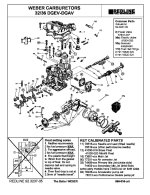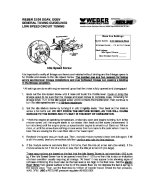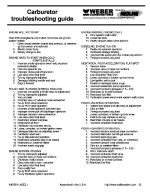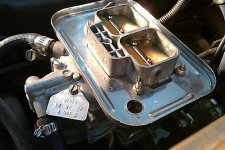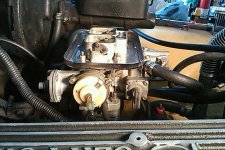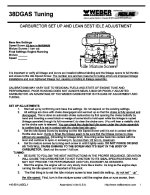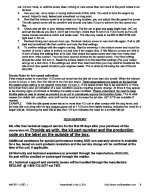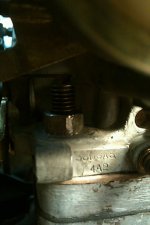I want to say its a 32/36 DGEV, but I can only go off of pictures, It was installed when I bought it, and I have no documentation. It has the electric choke.
Here are three that should help.
First lets positively identify your carb. If it is a genuine Italian designed Weber it will have the series and size stamped into the base flange of the body on the end opposite the choke.
Of these three if you will study the tune guide,... consider each line of it as proved Weber facts and be be much better attuned to what adjustments if any need to be made to it.
As far as the timing goes, it was idling but at a higher than normal rpm...about 1100. I realize it's not the right way, but I was just happy to hear it running again and I wanted to see if it made any difference.
Just as Terry mentioned some are required to set the initial timing by one scale while others will use the other. However one is better for discovery sake than the other that is the higher of the two.
If your engine is under computer control (C.E.C system)which means that all nine or ten switches, fixtures are working properly then you should use the 1600rpm setting however to do that you must first fully warm the engine as with either technique and then disconnect the electrical connection at the 4 &10Hg vacuum switches. They would be mounted to the firewall and one of the two will have a green cap/valve applied.
Now if you have nuttered the jeep ignition or have doubt that all the necessary C.E.C. system is functioning then set you timing at the curb idle speed once you verify the centrifugal availabe at 1600.
A note, if you set the nutered I6 engine to the factory recommended rpm then at idle speed one should expect to see 2* or very slightly under that at typical curb idle speed, so that if you bump it on up to say 8,9,10 or your preference up to say a max of 12* all is well unless knock occurs while having the heavy foot..
The purpose to using the factory technique is that when setting to 1600 at the recommended degree (most are 8* + or - two degrees). So that is the same as 6* to 10* BTDC at that speed. That is to determine how much centrifugal advance you have available in the advance head.
So say if you set initial to 8* at 1600 and then backed the speed down to curb idle where no centrifugal is in and then read the timing scale you could subtract it from the 1600 reading and know exactly what you have available.
Now if you have a functioning CEC system all things are good since the computer will allow advance as well as retardation of the total timing.
If you do not have a good CEC system for what ever reason then once you have determined what advance head is installed remember to bump the timing up to suit your driving need.
Weber by the way recommends at least 10-12 initial. If the ignition and engine are sound and in good working order then you should not expect to experience any ping/detonation unless you exceed that range.
Of course both techniques require you to disconnect and plug the vacuum advance tube.

